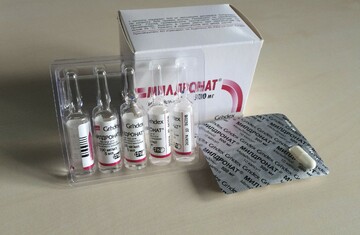RUSSIAN TENNIS STAR Maria Sharapova’s tense admission that she failed a dope test at the Australian Open shone a spotlight on Meldonium, added to the World Anti-Doping Agency’s banned list this year.
Sharapova said on Monday she had taken the drug on medical advice since 2006 under the name mildronate for a variety of symptoms.
Although she said she took it for health reasons, and not as a performance enhancer, she became the most high-profile athlete to test positive for the drug used to treat ischemia, a lack of blood flow to parts of the body.
The drug is manufactured in Latvia and prescribed to treat heart disease, although it is not approved by US regulators.
The increase in blood flow it produces could improve endurance and recovery time after exercise and WADA moved it from the “monitored” to the “prohibited” drugs list “because of evidence of its use by athletes with the intention of enhancing performance,” the anti-doping body said in a statement.
The ban approved last September came into effect on January 1.
Before Sharapova’s shock announcement in Los Angeles, Olympic gold medalist ice dancer Ekaterina Bobrova confirmed she had tested positive for Meldonium at the European Championships in January.
Ukrainian biathletes Artem Tyshchenko and Olga Abramova have also tested positive, Abramova saying she had been prescribed the drug for heart trouble.
This month reports surfaced that Endeshaw Negesse, the Ethiopian winner of last year’s Tokyo Marathon, had tested positive for the drug.
In February, Sweden’s Ethiopian born Abebe Aregawi, the 2013 women’s 1500m world champion was provisionally suspended for a failed test.








To think that she took up rugby 7 years ago and is now one of the most capable wingers in her sport. Incredibly talent. Good woman Ali
It’s catch and run. Not that difficult as she was already a top athlete
Catch and run? If that was the case, we would all be playing in the world cup.
It’s a lot more than catch and run, if you knew anything about rugby, you’d know that. Scarlett for ya buddy!
Ailbhe, don’t rise to the pathetic efforts of wind up merchants/trolls. People like him that don’t play or have never played rugby have no idea the level of skill and intelligence involved to be a top level player.
Ah Gary, I was just going to challenge him to a game. See if he can handle being dump tackled by a girl ;)
I repeat. Catch and run
Ok John, come to our training tonight. I’ll throw you the ball. You just simply catch and run….see how you fair. Up for the challenge? Or another keyboard warrior?
The best of luck to the Irish Ladies Rugby Team in their semi final against England. They have given a great lift to everyone with their achievements.
Stop running them down, they’re all lovely girls and they all have lovely bottoms.
Yours etc,
Niamh Horan
Played against her yrs back she tore us apart brilliant player, I’ve everything crossed for tomorrow I’m hoping for a Ireland/Canada final
I played against her too. When I tried to tackle her, I subluxed my shoulder. Out for nore than a month. I didn’t slow her down and I doubt I even altered her course. Ouch
Fantastic player Ali Miller is, best of luck tomorrow girls
She’s the type of athlete that can turn her hand to any type of sport.. Well done miller!!!
Ballet????
You are a muppet
Best of luck Ali